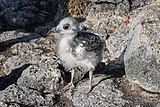Fork-tailed gull
| Fork-tailed gull | ||||||||||||
|---|---|---|---|---|---|---|---|---|---|---|---|---|

Fork-tailed gull |
||||||||||||
| Systematics | ||||||||||||
|
||||||||||||
| Scientific name of the genus | ||||||||||||
| Creagrus | ||||||||||||
| Bonaparte , 1854 | ||||||||||||
| Scientific name of the species | ||||||||||||
| Creagrus furcatus | ||||||||||||
| ( Neboux , 1842) |
The fork-tailed gull ( Creagrus furcatus ) is a 55-60 centimeter large nocturnal gull species that is represented in South America.
description
The fork-tailed gull has gray plumage. The head, beak and tail are black. The neck, belly and beak tip and base are white, legs and webbed feet are red. It has a red ring around the eyes, which makes them appear larger. The tail end is divided like a fork.
distribution
The fork-tailed gull is found in the Galapagos Islands and in Colombia, Ecuador and southern Peru. For the winter it moves to the islands in the northwest of South America. There are said to be around 30,000 animals.
Way of life
It hunts at sea in smaller flocks at night and stays at its nest on the coast during the day. The hunting intensity is particularly high at a new moon and therefore depends on the lunar cycle . As an adaptation to the nocturnal conditions, the birds' large eyes are particularly sensitive to light. On her hunting trips she covers distances of several hundred kilometers. It feeds on cuttlefish, crustaceans and other marine animals which it catches in flight on the surface of the water. It relies on its prey in rapid spiral flight maneuvers.
Reproduction
The fork-tailed gull breeds all year round and only lays one green or blue-white egg with purple dots. The nest consists of a small pile of stones that is laid out between rocks. The incubation period is 34 days. Both old birds take care of the young. The young do not leave the nest until they are 7 or 8 weeks old. After that, the two old birds continue to care for the young for several weeks.
Chicks in camouflage colors
Fork-tailed gull ( GFDL 1.2 )
Etymology and history of research
In 1840 Neboux described the fork-tailed gull under the common French name Mouette à queue fourchue . Since he did not assign a scientific name, this publication is not a first description according to the International Rules for Zoological Nomenclature . He named Monterey as the location . Since the species is practically never found in North American waters, the location was long considered questionable. Today we know that the species can very rarely occur as a stray visitor in this area during the El Niño . Another explanation would be a mix-up of the location information on the bellows that were collected during the voyage of the frigate Vénus, so that the type specimen may have been shot on the Galapagos Islands. The scientific name was first published in the zoological atlas of Voyage autour du monde sur la frégate la Vénus , which was published in several deliveries between 1842 and 1846. The illustration of the fork-tailed gull on plate 10 by Paul Louis Oudart (1796–1860) was part of delivery 2 from 1842. Since the atlas was not complete until 1846, the publication date 1846 is often incorrectly found in the literature. The scientific name on the The plaque read Larus furcatus . In 1854 Charles Lucien Jules Laurent Bonaparte introduced the genus Creagrus for the fork-tailed gull. This name is derived from the Greek »kreagra κρεαγρα « for »meat hook, hook«. The species name "furcatus" is the Latin word for "forked".
Hazards and protective measures
Because of its wide distribution and that no endangerments are known for this species, the IUCN classifies this species as ( Least Concern ) not endangered.
literature
- Adolphe Simon Neboux: Description d'oiseaux nouveaux recueillis pendant l'expédition de la Venus . In: Revue Zoologique par La Société Cuvierienne . tape 4 , 1840, p. 289-291 ( biodiversitylibrary.org ).
- Adolphe Simon Neboux in Abel Aubert Dupetit-Thouars: Voyage autour du monde sur la frégate la Vénus pendant les années 1836-1839 publié par ordre du Roi. Sous les auspices de Ministre de la Marine par Abel de Petit-Thouars, Capitaine de vaisseau, Grand-Officier de la Légion d'honneur . Atlas de Zoologie. Gide et J. Baudry, Paris 1846 ( digitalcollections.nypl.org ).
- Barbara Mearns , Richard Mearns: Audubon to Xantus: The Lives of Those Commemorated in North American Bird Names . Academic Press Limited, London 1992, ISBN 978-0-12-487423-7 .
- Charles Lucien Jules Laurent Bonaparte: Notes sur les Larides . In: Naumannia . tape 4 , 1854, p. 209-219 ( biodiversitylibrary.org ).
- James A. Jobling: Helm Dictionary of Scientific Bird Names . Christopher Helm, London 2010, ISBN 978-1-4081-2501-4 .
- Christopher M. Perrins : The Great Encyclopedia of Birds. From the English, Orbis-Verlag, Munich 1996, ISBN 3-572-00810-7 , pp. 147, 149.
- Jiří Felix (ed.), Alena Čepická: America's fauna in color. Translated from the Czech by Jaroslav Konšal. Karl Müller Verlag, Erlangen 1989, p. 169.
Web links
- Creagrus furcatus onthe IUCN 2013 Red List of Threatened Species . Listed by: BirdLife International, 2012. Retrieved January 14, 2014.
- photos
- Videos, photos and sound recordings of Creagrus furcatus in the Internet Bird Collection

